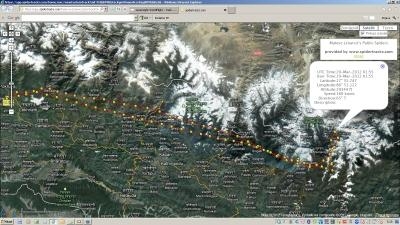Sat, Mar 31, 2012
First Ever Flight Of A Slovene Aircraft Over The Worlds Tallest Mountain
The Slovene pilot Matevž Lenarcic, who is flying around the world in his modified Virus SW 914 Turbo, made a successful flight over the world’s tallest mountain, Mt. Everest. On March 29th at 1:15 Central European time, Matevž flew by the Nepal side of the Mt. Everest summit at the height of 29,344 feet. This means he flew even higher than the top of the mountain.

"The weather was very beautiful, the temperature was relatively high, "only" -27°C, north westerly wind of 40 kts and from time to time some turbulence. The Pipistrel Virus performed perfectly" Matevž wrote on his website.
This historic moment means the first-ever flight of a Slovene aircraft over the world’s tallest mountain. "We have a proof that Matevž flew this high," said Ivo Boscarol, the general manager of the company Pipistrel that manufactured the modified Virus aircraft. "It is data released from an automated tracking device which tells the location, altitude and direction of flight. After landing in Jaipur, Matevž told me by telephone that the aircraft performed really well and would be able to climb even higher if he wanted or needed. This proved that our forecast, that the modified aircraft would be capable of reaching 10,000m was correct."
To be able to accomplish this feat, Matevž needed a specially modified aircraft able to withstand the temperatures as low as -50°C. He had to brave such temperatures once before when he landed his aircraft in the Antarctic.
There were a lot of trouble getting the permits to fly over the Everest (the Nepali permit got cancelled right before the flight), but Matevž did it anyway, so the news was held for a day to prevent him from having any trouble with Nepal authorities. Matevž is now already safely in India. The local Avia Club Nepal was of immense help with all the organisation issues and the logistics. They finally managed to convince the authorities to give Matevž the permission to fly above the Annapurna. Without their help this achievement would not be possible. In the days prior to the great success, Matevž did some test flights above the Himalaya to test the special oxygen mask. Then he flew on to accomplish probably the most difficult goal on his 43,000 nm flight around the world which will eventually take him over all 7 continents, 120 national parks and 3 oceans.
His return home is expected sometime in late April.
More News
A Puff Of Smoke Came Out From The Top Of The Engine Cowling Followed By A Total Loss Of Engine Power On May 9, 2025, about 1020 mountain daylight time, an experimental amateur-buil>[...]
From 2022 (YouTube Edition): Jenny, I’ve Got Your Number... Among the magnificent antique aircraft on display at EAA’s AirVenture 2022 was a 1918 Curtiss Jenny painstak>[...]
Very High Frequency (VHF) The frequency band between 30 and 300 MHz. Portions of this band, 108 to 118 MHz, are used for certain NAVAIDs; 118 to 136 MHz are used for civil air/grou>[...]
“From approximately November 2021 through January 2022, Britton-Harr, acting on behalf of AeroVanti, entered into lease-purchase agreements for five Piaggio-manufactured airc>[...]
From 2008 (YouTube Edition): US Fish and Wildlife Service Chooses The Kodiak To Monitor Waterfowl Populations Waterfowl all over North America may soon have to get used to a new ab>[...]
 NTSB Prelim: Lee Aviation LLC JA30 SuperStol
NTSB Prelim: Lee Aviation LLC JA30 SuperStol Classic Aero-TV: Curtiss Jenny Build Wows AirVenture Crowds
Classic Aero-TV: Curtiss Jenny Build Wows AirVenture Crowds ANN's Daily Aero-Term (05.30.25): Very High Frequency (VHF)
ANN's Daily Aero-Term (05.30.25): Very High Frequency (VHF) Aero-News: Quote of the Day (05.30.25)
Aero-News: Quote of the Day (05.30.25) Classic Aero-TV: Quest Kodiak Enhances Migration Monitoring Programs
Classic Aero-TV: Quest Kodiak Enhances Migration Monitoring Programs



